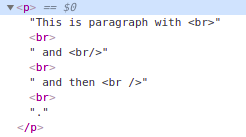In practice, using self-closing tags in HTML should work just like you'd expect. But if you are concerned about writing valid HTML5, you should understand how the use of such tags behaves within the two different two syntax forms you can use. HTML5 defines both an HTML syntax and an XHTML syntax, which are similar but not identical. Which one is used depends on the media type sent by the web server.
More than likely, your pages are being served as text/html, which follows the more lenient HTML syntax. In these cases, HTML5 allows certain start tags to have an optional / before it's terminating >. In these cases, the / is optional and ignored, so <hr> and <hr /> are identical. The HTML spec calls these "void elements", and gives a list of valid ones. Strictly speaking, the optional / is only valid within the start tags of these void elements; for example, <br /> and <hr /> are valid HTML5, but <p /> is not.
The HTML5 spec makes a clear distinction between what is correct for HTML authors and for web browser developers, with the second group being required to accept all kinds of invalid "legacy" syntax. In this case, it means that HTML5-compliant browsers will accept illegal self-closed tags, like <p />, and render them as you probably expect. But for an author, that page would not be valid HTML5. (More importantly, the DOM tree you get from using this kind of illegal syntax can be seriously screwed up; self-closed <span /> tags, for example, tend to mess things up a lot).
(In the unusual case that your server knows how to send XHTML files as an XML MIME type, the page needs to conform to the XHTML DTD and XML syntax. That means self-closing tags are required for those elements defined as such.)


\>, it should be closed as a useless fix-my-typo question. The answers all address/>. The/>version is the only useful one. Let it be. – Symphony